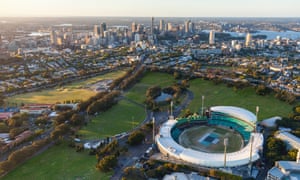Ping
@Suitman
Bold plan to build new Sydney stadium suspended above Central station
Sydney
Architects reveal design for 45,000-seat stadium over rail yards, but proposal meets with tepid government response

An image showing the proposed stadium design that would sit above rail lines near Central station. Photograph: Airphoto Australia/Bates Smart
A new stadium for
Sydney in the city centre and served by every major rail line, plus the chance to return Moore Park to parkland. It sounds like a utopian dream from an urban planner.
But architecture firm Bates Smart has produced just such a concept, which they have pitched to the NSW government: a 45,000-seat stadium over the platforms and adjacent rail yards at Central station instead of a new stadium at the site of the current Allianz stadium in Moore Park.
But despite the proposal’s merits it has been met with a tepid response from the
New South Wales government.
A government spokesperson said any unsolicited proposal needed “to be evaluated under the appropriate guidelines”.
Bates Smart director Philip Vivian says the idea is entirely possible – a stadium is a relatively light structure, equivalent to a six-storey building. The firm has asked engineering company Arup about its concept and believes it is entirely feasible.
“It would involve building a podium over the stations – it’s a matter of creating land – then the cost of the stadium on top would be the same, he said.
The new stadium would be served directly by all of Sydney’s rail lines, buses and the light rail, while being close to dining precincts in Haymarket and Surry Hills.
“It would create a piece of the city that heals a big scar in its fabric,” Vivian said of the concept of building over the vast expanse of rail lines in Sydney’s Central station area.
 FacebookTwitterPinterest
FacebookTwitterPinterest
An image of Moore Park with the Sydney Football Stadium removed and the Sydney Cricket Ground remaining. Photograph: Mark Merton/Bates Smart
“The Colosseum in Rome established the concept of the stadium as a public space embedded in the fabric of the city; a monumental piece of infrastructure for public spectacle. In modern times however, with the advent of the motor vehicle and the suburbs, stadiums became mono-functional objects, isolated on the periphery of the city and surrounded by car parking,” the Bates Smart brief says.
“Today a renaissance is under way, with stadiums once again being integrated into the city fabric and acting as catalysts of urban renewal,” it says.
But Bates Smart’s idea appears to have come too late to be given serious consideration by the NSW government.
Even though the government only announced its $1.5bn
final decision on redeveloping Sydney’s two stadiums in late March, the firm met with resistance when it pitched it in May.
The government has already commenced a design competition for the $729m rebuild of Allianz stadium, which will be the first of the two Sydney stadiums to be redeveloped. The other is the ANZ stadium at Homebush, which was built for the 2000 Olympics.
The government says it will be announcing the winner in a month and has plans to begin the project before the state election in March next year.
However, the NSW government has been prepared to upend planning processes in the past, when it considered there were benefits to NSW.
James Packer’s Crown Resorts convinced the O’Farrell government to entirely change the masterplan for Barangaroo six years into the massive project and move a public park away from the water’s edge in order to accommodate his casino on the water’s edge.
The government justified accepting the unsolicited proposal by Packer because of the tourism benefits and jobs the casino would bring to Sydney.
Vivian said a stadium at Central, rather than Moore Park would bring enormous benefits to the economy because the surrounding areas offered far more opportunities for visitors to spend money.
“A stadium should not be an isolated element on the edge of a city or in a park. What people want to do is extend their experience and go out for a meal or to a bar afterwards. At Allianz they spill out into nowhere,” he said.
“The NSW government often pays to get major events to Sydney but there’s nothing for tourists to spend their money on when they attend an event at Moore Park,” he said.
He also said the location would provide a better backdrop to showcase Sydney in international broadcasts, which would in turn help promote Sydney as a destination.
A stadium at Central would also allow Moore Park to be reclaimed as parkland and end the surrounding parkland being used as carparks when events were on.
“The whole problem with Moore Park is that it’s based on the outmoded concept of the automobile being the main form of getting to a game,” Vivian said.
Building a stadium at Central would also take the time pressure off the government’s plans and a potential blowout in costs as the old stadium at Moore Park could continue to operate until the new stadium is finished.
The government currently hopes to begin demolition of Allianz by the end of the year and have it completed by March 2022. The stadium at Homebush, which is now to be refurbished rather than rebuilt at a cost of $850m, is due for completion in mid 2021.
The Bates Smart idea will be up against some powerful potential opposition. Radio host Alan Jones and former News Corp managing director John Hartigan are on the board of the Sydney Cricket and Sports Ground Trust, which is chaired by former Transfield executive Tony Shepherd. The trust has been the driving force behind the redevelopment at Moore Park.
Several reports have recommended the two stadiums be brought under common ownership and managed jointly rather than as rival venues.
https://www.theguardian.com/austral...ydney-stadium-suspended-above-central-station










